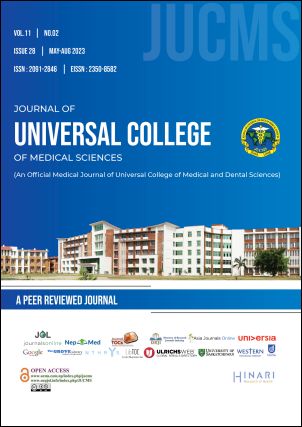Blunt Pulmonary Contusion: Admission Computed Tomography Scan Predicts Mechanical Ventilation
DOI:
https://doi.org/10.3126/jucms.v11i02.57892Keywords:
Blunt pulmonary contusion, Mechanical ventilationAbstract
INTRODUCTION Road traffic injury is one of the fastest growing health problems in Nepal with increasing number every year leading to morbidi- ty and mortality. Blunt pulmonary contusion may not be seen in the initial plain radiographs as they evolve over 12-24 hours. Thus CT (Computed Tomography) scan can provide detailed information about the contusion and predict the need for mechanical ventilation.
MATERIAL AND METHODS This is a prospective, observational longitudinal study conducted at Universal College of Medical Sciences, Bhairahawa from 1st January 2020 to 31st December 2020. The predictors for requirement of mechanical ventilation like Abbreviated Injury Scale (AIS), Injury Severity Score (ISS), GCS score and number of fractured ribs at the time of admission were recorded.
RESULTS In this study, 100 cases with blunt pulmonary contusion were evaluated. Average age of patients with blunt pulmonary contusion was around 39.10±17.56 years with male predominance (82%). Total of 7 patients required mechanical ventilation among whom the AIS chest was 3.0±0.82, ISS score was 29.14±6.89, and GCS 9.14±3.13. The ROC curve showed that ISS score predicted significantly about the requirement of mechanical ventilation with sensitivity of 85.5% and specificity of 99.8 %.
CONCLUSION Initial CT done in patients can show the presence or absence of pulmonary contusion and associated thoracic injuries and along with AIS, ISS and GCS scores we can predict early the requirement of mechanical ventilation.
Downloads
Downloads
Published
How to Cite
Issue
Section
License
Copyright (c) 2023 Journal of Universal College of Medical Sciences

This work is licensed under a Creative Commons Attribution-NonCommercial 4.0 International License.
Authors have to give the following undertakings along with their article:
- I/we declare that this article is original and has not been submitted to another journal for publication.
- I/we declare that I/we surrender all the rights to the editor of the journal and if published will be the property of the journal and we will not publish it anywhere else, in full or part, without the permission of the Chief Editor.
- Institutional ethical and research committee clearance certificate from the institution where work/research was done, is required to be submitted.
- Articles in the Journal are Open Access articles published under the Creative Commons CC BY-NC License (https://creativecommons.org/licenses/by-nc/4.0/)
- This license permits use, distribution and reproduction in any medium, provided the original work is properly cited, and it is not used for commercial purposes.




